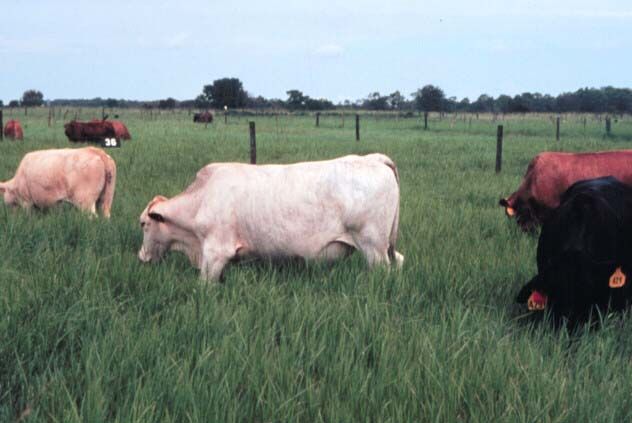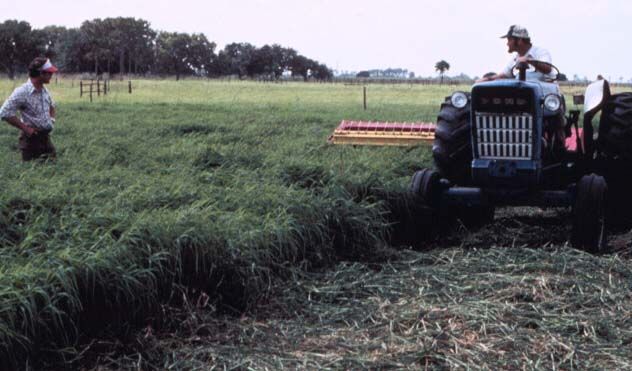Stargrass (Cynodon spp.), a member of the bermudagrass family, is also known as 'Giant stargrass' or 'African' stargrass.
Recommended varieties—Ona, Florona, Florico, and Okeechobee stargrasses
Stargrass is a warm-season perennial that grows vigorously and spreads rapidly after planting, provided adequate moisture and fertility are available. With proper management, these grasses can yield 2–2.5 T/A dry matter of good quality forage within 60 days after planting. Selected stargrasses continue to produce forage through the warm season and into the cool, dry season (December) in south central Florida when adequate fertility is available. Top growth is easily killed by frost, followed by a rapid decline in forage digestibility. Animal performance for many stargrasses has been excellent, producing live-weight gains (LWG) per acre and average daily gains (ADG) per animal about double that of bahiagrass. Large differences in persistence and in-vitro organic-matter digestion (IVOMD) exist between stargrass varieties. The persistence of both Florico and Florona has been superior to most other stargrasses tested at the UF/IFAS Range Cattle Research and Education Center (RCREC). The IVOMD of Florico stargrass has been generally 8–11 percentage units higher than Sarasota stargrass, regardless of harvest frequency and sampling date. Crude protein (CP) levels have been quite similar among stargrass varieties. Quality of stargrass hay, harvested every 4 to 5 weeks, is good to excellent.

Credit: C. G. Chambliss, UF/IFAS

Credit: C. G. Chambliss, UF/IFAS
Growing Conditions
Region of Adaptation
Stargrasses are well adapted to many soil types ranging from sands to clays. Stargrasses prefer moist, well-drained, fertile soils. However, stargrasses will tolerate short periods (3–5 days) of surface water (1–2 in.) and perform well under these conditions. Stargrasses do not tolerate long periods of flooding. The tropical nature of stargrasses limits their productivity and persistence to areas south of Orlando, Florida or where temperatures do not fall below 25°F.
Season of Growth
Stargrasses grow during the warm season but continue to make excellent growth under cool, short-day, fall conditions if fertilized in October. Grasses fertilized in October increased 168% (1.0 T/A) in dry biomass compared with no-fertilizer. With early February fertilization and moisture, Florona stargrass can produce a spring hay crop by late March. Once a stargrass is frosted, all desirable forage must be consumed within 1 week, since forage digestibility drops rapidly (~5%/wk). However, crude protein decreases more slowly (~1%/wk).
Cultural Practices
Establishment
Stargrasses are established vegetatively from mature (10- to 14-week-old) stem pieces. When placed in a moist, firm seedbed, nodes germinate in 5–10 days. These grasses are planted by distributing freshly cut planting material on clean (100% free of common bermudagrass and all other vegetation), moist, cultivated soil, covered by discing 2–4 in. deep (allowing 40% of stem to be exposed) or crimping stem pieces 4 in. deep into the soil followed by an extremely firm packing. Fresh planting material scattered on the soil surface must be covered with soil or crimped into the soil immediately after distribution (within 15 min) to prevent plant material from drying out. If plant material remains on the soil surface for 1.5 hrs, more than half of the vegetative stems die. Planting material must be uniformly distributed over the cultivated seedbed, with areas no larger than 3 ft2 devoid of planting material.
About 7–10 days after planting, and when signs of stargrass vegetative growth appear, the newly planted grass should be sprayed with 1 lb/A Weedmaster® in 20–30 gal/A water to help control annual sedges (watergrass) and broadleaf weeds. Delaying the herbicide application 20–30 days after planting results in little sedge control. Always read the herbicide label before using the herbicide to determine that it is currently labeled for the proposed use. Stargrass should also be fertilized 7–10 days after planting, when developing shoots are 1–3 in. tall using 35-35-35 lb/A N, P2O5, K2O, + 0.5% Cu, Zn, Mn, and Fe (sulfate form), 0.05% B and 1.0% S. A second application of N fertilizer (50 lb/A) should be applied 35 days after planting. The herbicide-plus-fertilizer combination should be sufficient to provide a dense stand of grass 24–30 in. tall within 60–75 days after planting.
Annual recommended fertilizer practices for grazing stargrass after the establishment year should be the equivalent of 200-30-60 lb/A N, P2O5, K2O, respectively, or follow the UF/IFAS standardized fertilization recommendation as given on your soil test report from the UF/IFAS Extension Soil Testing Laboratory (ESTL). Nitrogen or a complete fertilizer should be applied in three or four split applications for uniform seasonal production. If additional forage is not needed during the wet season, delay fertilizer application until the end of the rainy season; this will extend forage production into the fall. A pH of 5.5–6.0 is adequate for stargrass.
Weeds
Broadleaf weeds such as dogfennel and carolina geranium are easily controlled by applying 1 lb/A Weedmaster® when weeds are less than 6 in., and 1.5 lb/A when dogfennel is taller than 6 in. For harder-to-kill pasture weeds such as briers, consider the use of Remedy® (Triclopyr) at 1 lb/A active. Apply all herbicides in 30 gal water/acre. See the current IFAS Weed Management Guide for detailed information.
Insects
Insect problems on stargrass are generally limited to the striped grass looper and fall armyworm. Both insects will feed on stargrass and can destroy the entire crop if not controlled, especially following a fall fertilization.
The two-lined spittlebug has been found on stargrass but does not appear to cause any serious damage. However, if signs of spittlebug are evident, burning the previous year's stubble in January is one of the best control measures.
Disease
A "leafblight" disease (Rhizoctonia solani) has been found occasionally on most stargrass varieties during the middle of the rainy season. Stargrass grazed under a continuous system to a 6–10 in. stubble, or under a rotational system with a 4-week grazing interval, reveals no disease. The incidence of this disease seems to be associated with dense stands of tall, uncut, ungrazed forage and tends to disappear at the onset of the dry season. Cattle consume infected plants relatively well, with no signs of rejection.
Hydrocyanic Acid Potential (HCN-p)
Many stargrass varieties (Florico, Florona, Rhodesian, and Ona) have been reported to contain substantial amounts of hydrocyanic acid potential, also known as prussic acid. This chemical is also a concern in sorghums, white clover, etc. The HCN-p tends to be more of a problem, where seasonal temperature variations and stress conditions have created hazardous levels, especially following a freeze or frost. However, cattle have grazed stargrass at the Ona Experiment Station in all seasons since 1972 with no adverse effects.
Management and Utilization
Studies have demonstrated that stargrass should be allowed a rest period of 4–5 weeks between each clipping or grazing. This rest period can be extended by 1 or 2 weeks during periods of slow growth, such as cool or dry conditions, or shortened to 3 weeks during periods of lush growth, provided proper stubble height is maintained.
The above management variables result in excellent persistence and high dry matter (DM) yields (5–7 T/A) with good CP (11%–16%) and IVOMD (55%–60%). If the average rest period is shorter than 4 weeks, forage quality increases but persistence of the stand may decrease. If the rest period is increased to 7 weeks or more, persistence is good but CP (7%–8%) and IVOMD (42%–53%) are relatively low. Research has demonstrated that IVOMD and persistence are variable between stargrass varieties harvested at the same physiological stage. Florico stargrass tends to average about 2–3 percentage units higher IVOMD than Florona, Ona, or McCaleb stargrass. However, Florona stargrass generally expressed the greatest persistence and Ona stargrass the least persistence at the UF/IFAS Range Cattle REC. If managed as indicated above, Florico stargrass can have forage quality (IVOMD) equal to Pangola digitgrass.
The stubble height of most stargrasses should be maintained at 6–10 in. for best persistence. However, since plant height above the stubble has a major effect on forage yield and quality, plants should be grazed when plant height above the stubble ranges between 6 and 18 in. Research has shown that stubble height has an important effect on root development of stargrasses. Studies demonstrated root DM yield is reduced by 97%, compared with the unharvested check, when plants were repeatedly harvested back to a 2 in. stubble after attaining 6 in. of top growth above the stubble.
Grazing studies with stargrasses at the UF/IFAS Range Cattle REC produced a 3-yr ADG of 1.1 lb and LWG of 663 lb/A on Florico stargrass and ADG of 0.92 lb/A and LWG of 585 lb/A on Florona stargrass. Both grasses were stocked at three yearling steers per acre over a 200-day warm-season period. Average weight of the steers was 500 lb at the start of the period. Grasses were allowed a 4-week rest period between grazings.
Studies were conducted on stargrass to compare LWG and ADG with a 1- and 2-week cattle rotation. Cattle that were rotated weekly were on a five-pasture rotation and those cattle rotated every 2 weeks were on a three pasture rotation. Both rotations were allowed a 4-week regrowth period between grazings. Initial steer weights averaged 500 lb. When rotated weekly, live-weight gains for cattle grazing Florona (580 lb) and Florico (650 lb) averaged 14% and 6% higher, respectively, when compared with the 2-week rotation. Average daily gains also increased 11% on Florico and 6% on Florona when cattle were rotated weekly, compared with every 2 weeks.
Weaned beef-calf heifers grazing Florico and Florona stargrass, supplemented with a molasses-slurry mix (3 lb/head/day consumption) had gains (3-year average) of 0.90 and 0.84 pounds/head/day, respectively. Heifer weight gains from grazing Florico and Florona stargrass and fed a molasses slurry were 122 and 118 pounds/head, respectively, after 140 grazing days (3-year average) during the rainy season.
Summary
Advantages of Stargrass
- Rapid establishment from vegetative cuttings.
- Dry matter yields of stargrasses adapted to a specific location are excellent.
- A palatable and high quality forage when harvested at 4- to 5-week intervals and grazed at 4-week intervals.
- Florona stargrass is extremely persistent when properly managed.
- Some stargrasses make excellent growth under cool conditions, provided plants have adequate moisture and fertility.
- Stargrasses tend to produce more forage under drought conditions than Pangola digitgrass.
- Grazing studies at the Range Cattle REC during the warm season have yielded daily gains of .92–1.1 lb and LWG of 585–663 lb/A at a stocking rate of 3 yearling steers/A.
- Live-weight gains from stargrasses averaged 61% higher when compared with selected bermudagrasses.
- Rotating cattle weekly, compared to every 2 weeks, almost always resulted in higher LWG and ADG for stargrass.
- Hay cures rapidly during favorable weather conditions.
- Florona is the most desirable stargrass for a continuous hay harvest program.
Disadvantages of Stargrass
- Forage quality drops rapidly after 6–7 weeks of regrowth, with considerable rejection by cattle.
- Should not be grown where temperatures drop below 25°F.
- Requires higher fertility program than bahiagrass, Limpograss (Hemarthria), and Pangola digitgrass under Florida conditions.
- Vegetatively propagated from stem cuttings.
- Top growth easily killed by frost, followed by 5–6 percentage unit decrease in digestibility after 1 week and a 15–18 percentage unit decrease 4 weeks after a freeze.
- Most stargrasses contain high HCN-p following heavy nitrogen (100 lb N/A) fertilization any time during the growing season.